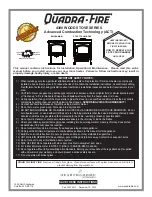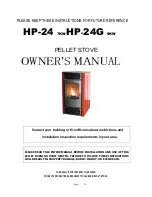
TERMOCUCINOTTA EVO DSA - TERMOCUCINOTTA DSA
25
12.10. MAINTENANCE ON THE WATER SYSTEM
Excessive incrustation deposits on the inner walls of the hearth considerably reduce the efficiency of heat exchange; therefore, remove
these deposits using a steel brush whenever necessary.
Never use corrosive substances that can damage the thermo-fireplace and
the boiler.
With the system switched off, once a year carry out the following checks:
• Check the operation and efficiency of the blowdown and safety valves. If they are defective, contact your authorised installer.
IT IS
STRICTLY FORBIDDEN TO REMOVE OR TAMPER WITH THE SAFETY DEVICES.
• Check the thermal insulation of the filling pipe and the safety pipe.
• Make sure that the system is filled and under pressure, checking the water level in the expansion tank; also check that it is working
properly and check the efficiency of the safety pipe.
13. CALCULATION OF THE THERMAL POWER
There is not an absolute rule for calculating the correct necessary power. This power is given according to the space to be heated, but it
depends also largely on the insulation. On an average, the calorific value necessary for a properly insulated room is
30 kcal/h per m
3
(for
an external temperature of 0°C).
Given that
1 kW corresponds to 860 kcal/h
, it is possible to adopt a value of
38 W/m
3
.
Let’s suppose one wishes to heat a room of 150 m
3
(10 x 6 x 2.5 m) in an insulated apartment. In this case, it is necessary to have 150 m
3
x 38 W/m
3
= 5700 W or 5,7 kW. As main heating, a 8 kW device is therefore sufficient.
Approximate combustion
value
Required quantity in relation to 1 kg of
dry wood
Fuel
Unit
kcal/h
kW
Dry wood (15% humidity)
kg
3600
4.2
1,00
Wet wood (50% humidity)
kg
1850
2.2
1,95
Wood briquettes
kg
4000
5.0
0,84
Brown coal briquettes
kg
4800
5.6
0,75
Normal anthracite
kg
7700
8.9
0,47
Coke
kg
6780
7.9
0,53
Natural gas
m
3
7800
9.1
0,46
Naphtha
L
8500
9.9
0,42
Electricity
kW/h
860
1.0
4,19
12.7. GLASS CLEANING
Thanks to a specific inlet of secondary air, the accumulation of dirty sediments on the glass-door is reduced with efficacy. Nevertheless this
can never be avoided by using solid fuels ( particularly wet wood ) and it has not to be understood as a defect of the appliance.
IMPORTANT: The cleaning of the sight glass must be carried out only and exclusively with cold device to avoid the explosion of
the same.
For the cleaning, it is possible to use specific products or a wet newspaper paper ball passed in the ash to rub it.
Do not
use cloths, abrasive or chemically aggressive products by cleaning the hearth glass
.
The correct lighting phase, the use of proper quantities and types of fuels, the correct position of the secondary air regulator, enough
draught of the chimney-flue and the presence of combustion air are the essential elements for the optimal functioning of the appliance and
for the cleaning of the glass.
BREAK OF GLASSES: Given that the glass-ceramic glasses resist up to a heat shock of 750°C, they are not subject to thermal
shocks. Their break can be caused only by mechanic shocks (bumps or violent closure of the door, etc.). Therefore, their
replacement is not included in the warranty
.
12.8. CLEANING OUT THE ASHES
All the devices are equipped with a hearth grating and an ash drawer for the collection of the ashes.
It is suggested to empty periodically the ash drawer and to avoid it fills completely in order not to overheat the grating. Moreover, it is
suggested to leave always 3-4 cm of ash in the hearth.
CAUTION
:
The ashes removed from the hearth have to be stored in a container made of fire-resistant material equipped with an
air-tight cover. The container has to be placed on a fire-resistant floor, far from flammable materials up to the switching off
and complete cooling.
12.9. CLEANING THE FLUE
The correct lighting phase, the use of proper quantities and types of fuels, the correct position of the secondary air regulator, enough
draught of the chimney-flue and the presence of combustion air are the essential elements for the optimal functioning of the appliance.
The device should be completely cleaned at least once a year or every time it is needed (in case of bad working and low yield). An
excessive deposit of soot can cause problems in the discharge of smokes and fire in the flue.
The cleaning must be carried out exclusively with cold equipment.
This operation should be carried out by a chimney sweeper who
can simultaneously perform an audit of the flue (checking of possible deposits).
















































